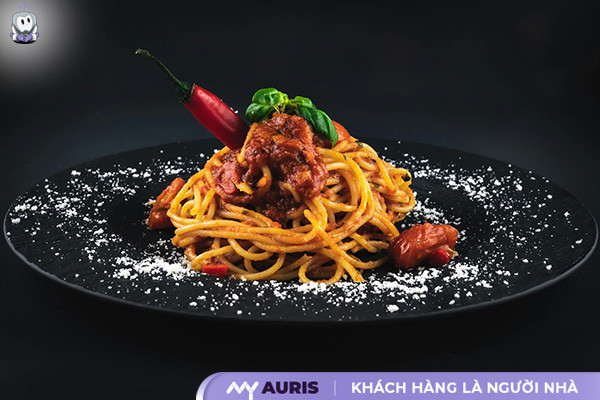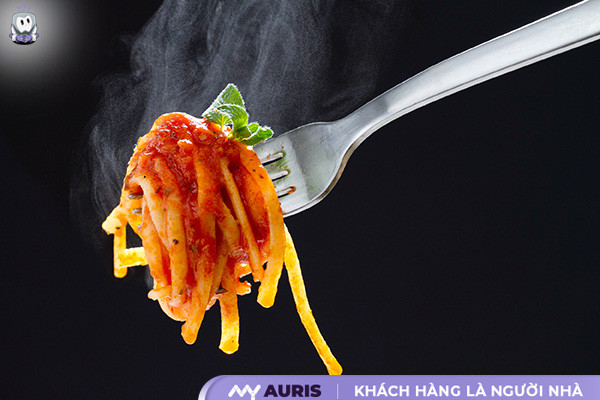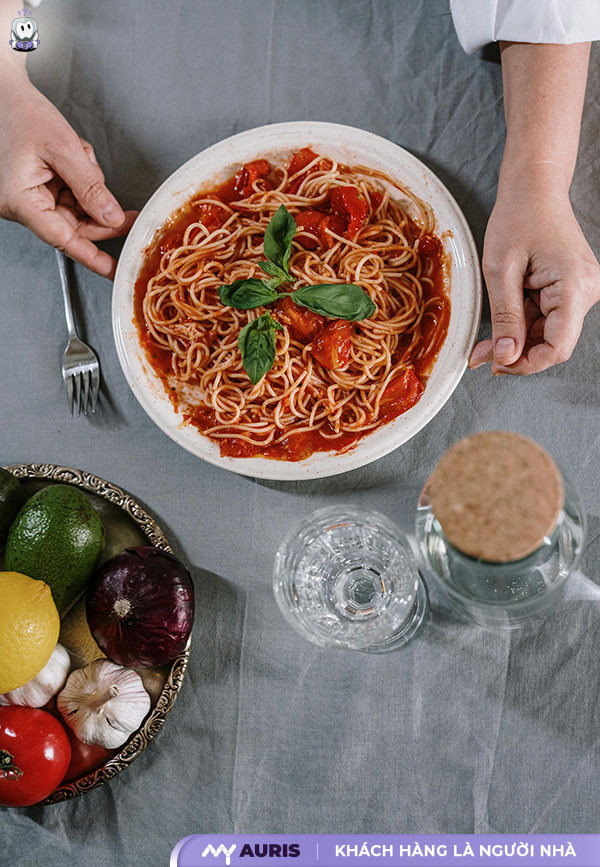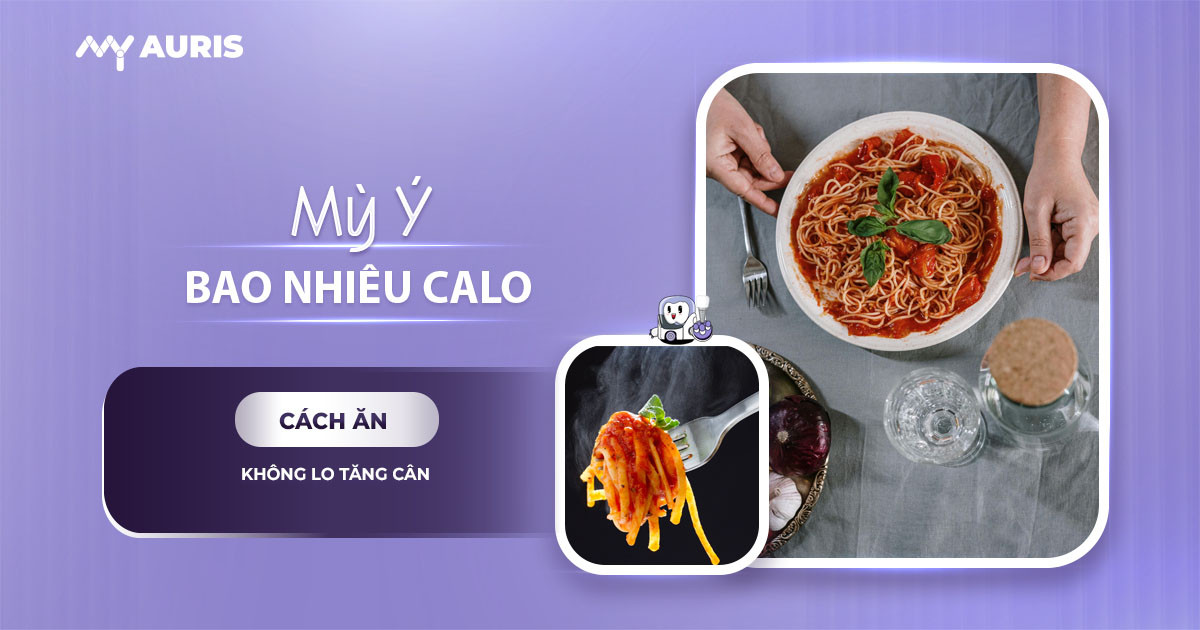Many people worry that Spaghetti will affect their weight loss plan. In reality, the calorie count is not fixed. It depends on the type of pasta, how it’s prepared, and especially the type of sauce you choose. Understanding these factors helps you control your meals better, rather than completely eliminating a delicious dish.
How many calories in Spaghetti?
The question is, how many calories are in Spaghetti? On average, 100 grams of dry (uncooked) Spaghetti contains about 370 calories. This is the number you typically see on product packaging. When you cook pasta, the strands absorb water, expand, and increase in weight. Therefore, 100 grams of cooked Spaghetti contains only about 130 to 160 calories. This difference comes from the amount of water the pasta absorbs.
Many people believe that Spaghetti makes you fat. The truth is not entirely so. The calorie content in a plate of Spaghetti largely depends on two factors: the type of pasta you use and, more importantly, the type of sauce you choose. Understanding the energy of each ingredient helps you effectively manage your weight without giving up your favorite Italian dish. A balanced meal can absolutely include Spaghetti.

Calories in Different Types of Pasta:
Spaghetti from Regular White Flour: This is the most common type. How many calories are in 100g of cooked spaghetti? The answer is about 155 – 160 calories. This is the basic energy level you need to remember. It provides carbohydrates for quick energy for the body.
Whole Wheat Spaghetti: This type of pasta contains more fiber. 100g of cooked whole wheat pasta contains about 140 – 150 calories, slightly lower than white pasta. Its biggest benefit is that fiber helps you feel full longer, supporting effective weight management.
Gluten-free Spaghetti: Made from corn, rice, or legumes. Their calorie content is comparable to white pasta, around 150 – 160 calories per 100g cooked. This option is suitable for people with gluten allergies, not necessarily a weight loss choice.
Buckwheat Spaghetti: A less common but nutrient-rich option. Calories in buckwheat pasta are lower, around 110 – 125 calories per 100g cooked, while also providing plenty of protein and minerals.
Calories in Different Types of Sauces:
Tomato Sauce (Marinara): A serving of tomato sauce (about 125g) contains only 70 – 90 calories. This is the most basic and lowest-energy sauce. It’s made primarily from tomatoes, garlic, onion, and herbs.
Minced Beef Sauce (Bolognese): how many calories in spaghetti bolognese a serving of Bolognese sauce contains about 150 – 250 calories, depending on the amount and leanness of the meat.
Creamy Cheese Sauce (Alfredo or Carbonara): Traditional Spaghetti Carbonara sauce uses eggs, cheese, cured pork jowl (guanciale), and black pepper. A serving of this type of sauce can easily exceed 400 – 500 calories.
Pesto Sauce: A small serving (about 60g) already contains 250 – 300 calories. Made from fresh basil, garlic, pine nuts, Parmesan cheese, and olive oil.
How many calories in seafood spaghetti? A plate of seafood spaghetti with tomato sauce typically has about 120 – 180 calories for the sauce portion. If it’s a creamy sauce, that number will skyrocket. This dish is often prepared with tomato sauce or olive oil and garlic sauce. Calories depend on the type of seafood and preparation method.
Summary table of estimated total calories for a plate of Spaghetti (approximately 200g cooked pasta combined with 150g sauce):
| Dish Name | Estimated Calories (per plate) | Notes |
| Spaghetti with Tomato Sauce | 380 – 430 calories | Lower calorie option, suitable for diets. |
| Spaghetti Bolognese (Minced Beef Sauce) | 470 – 570 calories | Provides plenty of protein, balanced in energy and nutrition. |
| Spaghetti Carbonara | 700 – 850+ calories | Very high in calories, contains lots of saturated fat. |
| Fettuccine Alfredo | 750 – 900+ calories | Similar to Carbonara, rich in cream and butter, very high in calories. |
| Spaghetti with Pesto Sauce | 650 – 750 calories | High in calories but contains good fats from olive oil and nuts. |
| Seafood Spaghetti (Tomato Sauce) | 440 – 500 calories | Good option, provides lean protein from seafood. |

Nutritional Value of Spaghetti
Estimated Nutritional Value Comparison Table for 100g Dry Spaghetti
| Nutritional Component | Traditional Spaghetti (Semolina Flour) | Whole Wheat Spaghetti | Gluten-Free Spaghetti (Rice/Corn-based) |
| Energy (Calories) | ~ 370 kcal | ~ 350 kcal | ~ 360 kcal |
| Carbohydrates | ~ 75 g | ~ 70 g | ~ 79 g |
| Fiber | ~ 3 g | ~ 7 g | ~ 2 g |
| Protein | ~ 13 g | ~ 14 g | ~ 7 g |
| Fat | ~ 1.5 g | ~ 2.5 g | ~ 1.5 g |
Does eating Spaghetti cause weight gain?
The direct answer is no. Spaghetti itself is not a fattening food. Weight gain is not dependent on a single dish, but rather the result of a prolonged calorie imbalance. This occurs when the total energy you consume from all foods and drinks exceeds the energy you expend through daily activities. The main factors influencing whether eating spaghetti causes you to gain weight include: portion size, the type of sauce used, and accompanying ingredients. When these three factors are well controlled, spaghetti becomes part of a healthy diet, helping you manage your weight effectively.

Tips to Reduce Calories When Making Spaghetti at Home
The foundation of the dish starts with the pasta itself. Instead of choosing pasta made from refined white flour, prioritize the following options:
Whole Wheat Spaghetti (Whole Wheat Pasta): This is the top choice. Whole wheat pasta contains more fiber, protein, and micronutrients. Fiber helps you feel full longer, reduces cravings, and supports the digestive system. The nutritional content of whole wheat spaghetti is far superior to the regular type.
Legume-based Pasta: Pasta made from chickpeas or lentils has a very high protein and fiber content, while being lower in carbohydrates. This is an excellent option for weight loss diets and those needing to supplement protein.
Gluten-free or Vegetable-based Spaghetti: Options like spaghetti made from buckwheat flour or vegetable noodles (zucchini, carrots) provide a calorie-free or significantly lower-calorie solution, enriching your diet menu.
Strict Portion Control: A standard serving of spaghetti for one person on a weight loss diet should only be 50-75 grams of dry pasta. Don’t estimate by eye. Use a kitchen scale to accurately measure the pasta before cooking.
Make Your Own Sauce at Home to Control Ingredients
Prioritize Tomato-based Sauces: Make sauces from fresh tomatoes, garlic, onion, and herbs. Natural tomato sauce is low in calories and rich in lycopene, an antioxidant good for health.
Limit Cream and Cheese Sauces: Creamy sauces like Spaghetti Carbonara or cheese sauces are very high in calories and fat. If you still want a rich flavor, try using unsweetened Greek yogurt or a small amount of Parmesan cheese to sprinkle on top instead of mixing it in.
Boost Vegetables and Lean Protein: Add vegetables like broccoli, bell peppers, mushrooms, spinach, and asparagus to your pasta dish. Vegetables increase the volume of the meal, helping you feel full faster with fewer calories. Instead of smoked bacon or sausage in Bolognese sauce, opt for chicken breast, shrimp, fish, or legumes. These protein sources help build muscle and keep you full longer.

Compare Spaghetti Calories with Familiar Vietnamese Dishes
For an overview, let’s consider the estimated calorie content in standard servings. These numbers can vary depending on the recipe and vendor, but they provide a useful reference framework.
| Dish | Weight (Estimated) | Calorie Count (Estimated) |
| Spaghetti Bolognese (Minced Beef Sauce) | 350g | 450 – 550 calories |
| Spaghetti Carbonara (Cream Sauce) | 350g | 600 – 750 calories |
| Rare Beef Pho | 1 medium bowl | 350 – 450 calories |
| Special Beef Pho (flank, brisket, tendon) | 1 large bowl | 550 – 650 calories |
| Bun Cha | 1 full serving | 500 – 600 calories |
| Broken Rice with Pork Rib, Shredded Pork Skin, and Egg Meatloaf | 1 plate | 550 – 700 calories |
| Banh Mi Thit (Pork Sandwich) | 1 loaf | 400 – 500 calories |





